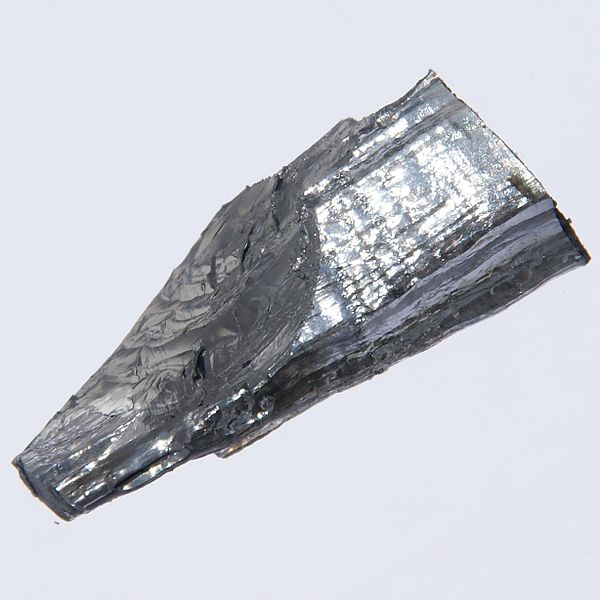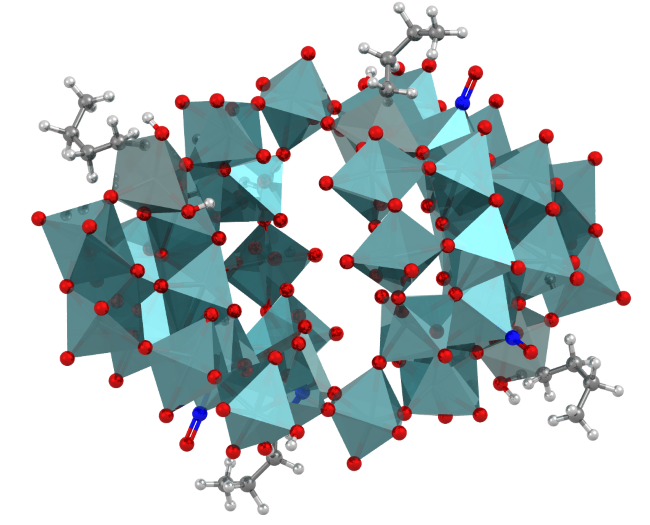Molybdenum
Molybdenum:

Image showing a crystal of pure molybdenum metal
Facts about Molybdenum:
- Molybdenum: Silvery-grey hard ductile metal at standard conditions
- Fun fact about Molybdenum: Molybdenum has one of the highest melting points of all pure elements – over 2,600 deg.C! Only the elements tantalum and tungsten have higher melting points.
- Chemical symbol: Mo
- Atomic number: 42
A crystal structure containing Molybdenum:

The polyoxomolybdate cluster containing molybdenum in three different oxidation states. Mo atoms sit in the center of the blue-green polyhedral shapes and the polyhedra show how the Mo atom is connected to neighbouring oxygen atoms
Facts about this structure:
- Formula: 16(H3O+), C16H74Mo34N4O132Sn416-, 18(H2O)
- Structure name:hexadecakis(Oxonium) tetrakis(mu-4-oxo)-icosakis(mu-3-oxo)-bis(mu-2-aqua)-tetracontakis(mu-2-oxo)-tetradeca-aqua-tetra-n-butyl-hexahydroxy-tetra-nitrosyl-dotetraconta-oxo-octacosa-molybdenum(vi)-di-molybdenum(v)-tetra-molybdenum(ii)-tetra-tin octadecahydrate
- Fun fact about the structure: As a transition metal molybdenum can adopt many different oxidation states. This structure is the only one in the CSD with molybdenum in 2+, 5+ and 6+ states in a single structure!
- CSD refcode: NIYWAU (What’s this?)
- Associated publication: Hun-Li Li, Yong-Mei Zhang, Jian-Fang Ma, Ya-Qian Lan, Jin Yang, Dalton Transactions, 2008, 1000, DOI: 10.1039/b714915h
More about Molybdenum:
The word molybdenum comes from the ancient Greek word molybdos, meaning lead, since minerals containing the two elements have a very similar appearance. Even though molybdenum is not found in its pure metallic form in nature as a free metal, it is an essential element in most organisms. Enzymes containing molybdenum are commonly found in bacteria for the process of biological nitrogen fixation (breaking the chemical bond in atmospheric molecular nitrogen to obtain a more biologically-useful form). Due to its hardness, very high melting point and resistance to corrosion molybdenum is often included in metal alloys such as stainless steel.
Learn More About the International Year of the Periodic Table (IYPT) in Crystals Project:
This project (#IYPTCrystals) is part of the International Year of the Periodic Table celebration (#IYPT2019), read more about the project here.
You can follow us on social media; search for #IYPTCrystals or follow The CCDC on X @ccdc_cambridge on Facebook ccdc.cambridge, on Instagram ccdc_cambridge or on YouTube CCDCCambridge.
Understand some of the terms and concepts used with our Frequently Asked Questions page here.
A 3D visualization showing Molybdenum in real crystal structures: